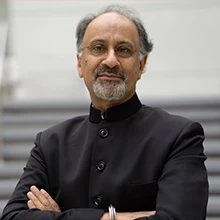 Photo credit: Gerardo Pesantez / World Bank
Photo credit: Gerardo Pesantez / World Bank
Only six months ago, a “soft landing” appeared to be in sight: the global economy was stabilizing after an extraordinary string of calamities both natural and man-made over the past few years. That moment has passed. The world economy today is once more running into turbulence. Without a swift course correction, the harm to living standards could be deep.
International discord—about trade, in particular—has upended many of the policy certainties that helped shrink extreme poverty and expand prosperity after the end of World War II. This year alone, our forecasts indicate the upheaval will slice nearly half a percentage point off the global gross domestic product (GDP) growth rate that had been expected at the start of the year, cutting it to 2.3 percent. That’s the weakest performance in 17 years, outside of outright global recessions. By 2027, global GDP growth is expected to average just 2.5 percent in the 2020s—the slowest pace of any decade since the 1960s.
As our latest Global Economic Prospects report makes clear, the poorest countries will suffer the most. Most of the developing world is turning into a development-free zone. By 2027, the per capita GDP of high-income economies will be roughly where it had been expected to be before the COVID-19 pandemic. But developing economies would be worse off, with per capita GDP levels 6 percent lower. Except for China, it could take these economies about two decades to recoup the economic losses of the 2020s.
This grim predicament did not arrive by stealth. It has been advertising itself for at least a decade. Growth in developing economies has now been ratcheting downward for three decades in a row, from an average of 5.9 percent in the 2000s to 5.1 percent in the 2010s to 3.7 percent in the 2020s. That happens to track the declining trajectory of growth in global trade, which has fallen from an average of 5.1 percent in the 2000s to 4.6 percent in the 2010s to 2.6 percent in the 2020s. Investment, meanwhile, has been growing at a progressively weaker pace. But debt is piling up.
In short, many of the forces behind the great economic miracle of the last 50 years—when per capita GDP in developing countries nearly quadrupled and more than 1 billion people escaped extreme poverty—have swung into reverse. Conditions that might have facilitated relatively painless policy corrections have come and gone—the record-low interest rates that prevailed in the first two decades of this century, for example, are now a thing of the past. Through it all, policymakers mostly stood still, hoping that conditions would somehow improve on their own. That was a false hope, but it is never too late to do the right thing. This report outlines three priorities:
First, rebuild trade relations. The evidence is clear: economic cooperation is better than any of the alternatives—for all parties. Our analysis suggests that if today’s trade disputes were resolved with agreements that halve tariffs relative to their levels in late May 2025, global growth could be stronger by about 0.2 percentage points on average over the course of 2025 and 2026.
Most developing economies today tend to have far higher tariffs than high-income economies. If their goal is to accelerate growth, their best course of action will be to lower tariffs with respect to all trading partners. Converting preferential trade agreements, mainly involving tariffs, into “deep trade agreements” that span the full range of cross-border regulatory policies could also juice GDP growth. Developing economies also have a crucial role to play in restoring a fully functional, rules-based trade system, specifically through the World Trade Organization. Predictability cuts trade costs, which in turn boosts GDP growth.
Second, restore fiscal order. It’s fair to say that the succession of economic shocks in the 2020s has made a mess of government finances in many developing economies. But they were hardly the sole cause: In the era of easy money that preceded the COVID-19 pandemic, governments opted to take too many risks for far too long. The bill is now due: fiscal deficits so far in the 2020s have averaged nearly 6 percent in developing economies, the highest level of this century. Interest costs alone account for about a third of the deficits. In low-income countries, the budget squeeze has been intensified by a drop in foreign aid, which finances a big share of critical needs such as health care. It should be no surprise that more than half of low-income countries are now either in debt distress or at high risk of it.
Developing economies need to expand their fiscal room to maneuver. They have a lot of work to do in this regard, because they collect far less in revenues than high-income economies do—about 25 percent of GDP compared with nearly 40 percent of GDP in the wealthiest economies. They should step up efforts to mobilize greater domestic resources by broadening the tax base and strengthening tax administration and collection to reduce tax avoidance and profit-shifting. They can also reap significant gains by narrowing the focus of costly food and fuel subsidies, channeling them simply toward low-income households.
Third, accelerate job creation. Across the world, a historic demographic shift is underway, one that is intensifying the need for jobs in many of the poorest countries. Sub-Saharan Africa’s working-age population is forecast to almost double by 2050, growing by more than 600 million, more than any region has ever experienced over a 25-year period. South Asia’s working-age population is expected to expand by nearly 300 million over the same timeframe, and the Middle East and North Africa’s by more than 100 million.
Whether these regions succeed or fail in tackling the challenge will determine the outlook for long-term global peace and prosperity. They will need to accelerate economic growth, upgrade the workforce’s education and skills, and set the stage for labor markets to function efficiently.
The global economy today is at an inflection point. The forces that once drove economic convergence and lifted billions out of poverty are now in retreat. But this moment offers a chance to reset the agenda with renewed global cooperation, restored fiscal responsibility, and a relentless focus on creating jobs. With decisive action, governments across the world can still regain the momentum of poverty reduction—and deliver rising living standards for the next generation.
A serious growth problem
Global GDP growth is exceptionally feeble, not only from year-to-year but also decade-to-decade
Chart 1: Slowest Annual Growth Since 2008 Outside of Recessions
Chart 2: Slowest Decade-Level Growth Since 1960s



Join the Conversation